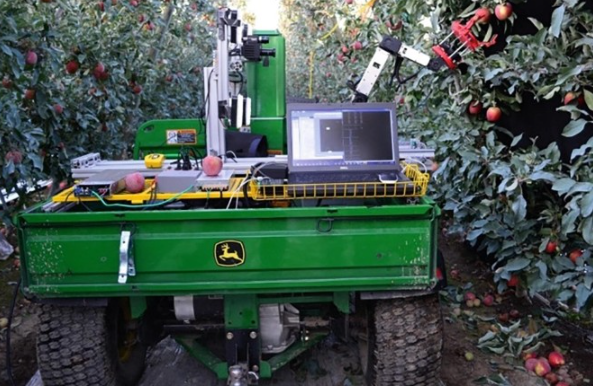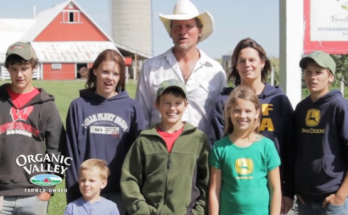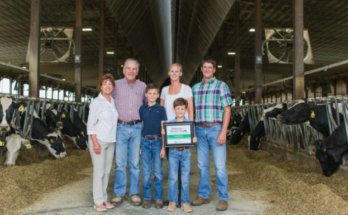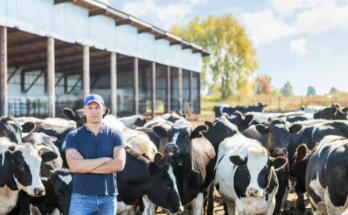Autonomous Robotic Kiwifruit Harvesting and Pollination as developed by the University of Auckland, University of Waikato, Plant and Food Research, and RoboticsPlus ltd.
**Autonomous Robotic Kiwifruit Harvesting and Pollination (CARES)**
The development of **Autonomous Robotic Kiwifruit Harvesting and Pollination (CARES)** is an innovative project aimed at addressing key challenges in modern agriculture, particularly in the kiwi fruit industry. With labor shortages, rising operational costs, and increasing pressure to produce higher-quality, sustainably-grown fruit, automation and robotics have emerged as potential solutions. CARES is designed to improve both the efficiency of kiwifruit harvesting and the process of pollination, both critical stages in maximizing crop yield and quality.
**The Role of Autonomous Robotics in Harvesting and Pollination**
The CARES project combines advanced robotics, artificial intelligence (AI), and machine learning to develop autonomous systems capable of both harvesting and pollinating kiwifruit plants. Robotic harvesters use high-tech sensors, cameras, and AI to precisely identify ripe kiwifruits on the vine. This allows the robots to pick the fruit without damaging it, a critical factor in preserving the fruit’s quality for commercial markets. These autonomous harvesters are programmed to assess the fruit’s size, shape, and ripeness, ensuring that only the best quality kiwis are harvested at the optimal time.
Pollination is another key focus of the CARES project. Kiwifruits require specific pollination conditions to achieve high-quality yields. In conventional farming, this process is usually managed by introducing bees or other pollinators. However, autonomous robotic pollinators are being developed to mimic this process more efficiently. These robots use precise technology to distribute pollen across the plants in a way that maximizes fertilization and reduces the reliance on insect populations, which are increasingly threatened by environmental factors.
**Budget, Spending, and the Release Date for CARES**
The development of autonomous robotic systems like those in the CARES project requires significant investment, both in research and infrastructure. Funding for the CARES initiative typically comes from a combination of government grants, private sector investments, and industry partnerships. For example, government agencies such as the U.S. Department of Agriculture (USDA) and agricultural innovation bodies in New Zealand (a major kiwi-producing country) often allocate specific budgets to support projects that aim to enhance food security, improve farming practices, and increase sustainability.
The **release date for such funding** often aligns with annual agricultural budget cycles, with grants and subsidies being announced in the early part of the fiscal year. These funds help cover the costs of research, prototype development, and the commercialization of technology. By ensuring the timely release of these budgets, farmers and technology developers can move forward with creating practical and scalable robotic solutions that benefit the broader agricultural industry.
**The Success of CARES and the Benefits for Farmers**
The CARES initiative has shown promise in increasing both the **efficiency and sustainability** of kiwifruit farming. One of the key benefits of robotic systems is the reduction in labor costs, a significant issue in many regions where manual labor is becoming more expensive or harder to find. Automated systems not only reduce the cost of labor but also improve the precision of harvesting and pollination, which leads to better fruit quality and higher yields.
For farmers, the **success of CARES** means reduced dependency on seasonal workers, fewer issues with over-harvesting or under-pollination, and the ability to operate in a more sustainable and environmentally friendly manner. The robots are designed to work with minimal energy consumption, reducing the environmental impact of traditional farming methods. Furthermore, as the technology continues to evolve, the robots are expected to perform more complex tasks, such as pruning, weeding, and pest management, which will further boost farm efficiency and productivity.
**Farm Resources and Support for Kiwi Farmers**
Farmers who adopt the CARES technology can access support from both government and industry bodies. Government programs often provide funding, training, and access to resources that help farmers integrate new technologies into their operations. In addition, agriculture technology companies involved in CARES can provide technical support, ensuring that farmers can maximize the benefits of automation on their farms. **Farmers can also rely on agricultural cooperatives and trade associations** to stay informed about the latest developments in robotic farming technology and to gain access to research, grants, and other support services.
In conclusion, the CARES project represents a significant leap forward in the automation of kiwifruit farming. By introducing autonomous robotic harvesting and pollination, farmers can expect to see improvements in yield quality, labor efficiency, and sustainability. With appropriate financial support and a clear release of budget funds, these advancements hold the potential to revolutionize the kiwi fruit industry and set a new standard for agricultural technology.



